One Column Test
“Lorem ipsum dolor sit amet, consectetur adipiscing elit, sed do eiusmod tempor incididunt ut labore et dolore magna aliqua. Ut enim ad minim veniam, quis nostrud exercitation ullamco laboris nisi ut aliquip ex ea commodo consequat. Duis aute irure dolor in reprehenderit in voluptate velit esse cillum dolore eu fugiat nulla pariatur
“Lorem ipsum dolor sit amet, consectetur adipiscing elit, sed do eiusmod tempor incididunt ut labore et dolore magna aliqua. Ut enim ad minim veniam, quis nostrud exercitation ullamco laboris nisi ut aliquip ex ea commodo consequat. Duis aute irure dolor in reprehenderit in voluptate velit esse cillum dolore eu fugiat nulla pariatur
Two Column Test
“Lorem ipsum dolor sit amet, consectetur adipiscing elit, sed do eiusmod tempor incididunt ut labore et dolore magna aliqua. Ut enim ad minim veniam, quis nostrud exercitation ullamco laboris nisi ut aliquip ex ea commodo consequat. Duis aute irure dolor in reprehenderit in voluptate velit esse cillum dolore eu fugiat nulla pariatur
“Lorem ipsum dolor sit amet, consectetur adipiscing elit, sed do eiusmod tempor incididunt ut labore et dolore magna aliqua. Ut enim ad minim veniam, quis nostrud exercitation ullamco laboris nisi ut aliquip ex ea commodo consequat. Duis aute irure dolor in reprehenderit in voluptate velit esse cillum dolore eu fugiat nulla pariatur
“Lorem ipsum dolor sit amet, consectetur adipiscing elit, sed do eiusmod tempor incididunt ut labore et dolore magna aliqua. Ut enim ad minim veniam, quis nostrud exercitation ullamco laboris nisi ut aliquip ex ea commodo consequat. Duis aute irure dolor in reprehenderit in voluptate velit esse cillum dolore eu fugiat nulla pariatur
“Lorem ipsum dolor sit amet, consectetur adipiscing elit, sed do eiusmod tempor incididunt ut labore et dolore magna aliqua. Ut enim ad minim veniam, quis nostrud exercitation ullamco laboris nisi ut aliquip ex ea commodo consequat. Duis aute irure dolor in reprehenderit in voluptate velit esse cillum dolore eu fugiat nulla pariatur
Infertility
in numbers

1 in 6
Australian couples of reproductive age1
female or
male at birth1

1 in 3 cases
are related to fertility issues in people assigned female at birth
1 in 3 cases
are related to fertility issues in people assigned male at birth
1 in 3 cases
are related to fertility issues with both or ultimately the cause is unknownHow to be your healthiest you
It’s important to take a holistic approach to your lifestyle choices and try to be as proactive as possible in ‘staying healthy’.
There isn’t just one thing that will ‘fix’ infertility. However, all the little choices you make do add up and can play instrumental roles in supporting fertility.
Which tips can you commit to adding or subtracting from your daily routine?
It’s important to take a holistic approach to your lifestyle choices and try to be as proactive as possible in ‘staying healthy’.
There isn’t just one thing that will ‘fix’ infertility. However, all the little choices you make do add up and can play instrumental roles in supporting fertility.
Which tips can you commit to adding or subtracting from your daily routine?
Do
-

Eat the rainbows when it comes to fruit and veggies7
The more colours you add, the more variety in nutritional value.
-

Switch to organic foods or those that have less toxins7
Unfortunately, toxins do find a way of making it into our foods. Switching to organic can help minimise exposure to unwanted toxins.7,10
-

Wash fruits and vegetables before eating to remove toxins10
Unfortunately, toxins do find a way of making it into our foods. Try washing fruits and vegetables to help minimise exposure to unwanted toxins.7,10
-

Keep a healthy weight8,9
Extra weight can impact hormone levels, which in turn can affect the menstrual cycle and quality of eggs or sperm.
-

Commit to regular exercise (75 mins intense or 150 mins moderate per week)7
Regular exercise not only helps you maintain a healthy weight but can also keep you strong in preparation for your fertility journey.
-

Manage stress through mindful movement7
Stress can have a negative impact on nearly all parts of your life. By adding mindful movement (like meditation and yoga) you can help reduce stress.
What is assisted pregnancy?
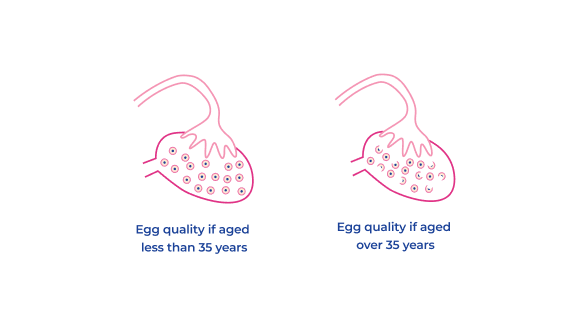
Test
This is a test This is a test This is a test This is a test This is a test This is a test This is a test This is a test This is a test This is a test This is a test This is a test This is a test This is a test This is a test This is a test This is a test This is a test This is a test This is a test This is a test This is a test This is a test This is a test
This a link for longer text labelIn doing this, they will start by gathering information about you (and your partner) from your medical history and results of physical exams and tests.
Click on the topics to get prepared for questions that your fertility specialist may ask.
Lorem ipsum dolor sit amet, consectetur adipiscing elit, sed do eiusmod tempor incididunt ut labore et dolore magna aliqua. Ut enim ad minim veniam, quis nostrud exercitation ullamco laboris nisi ut aliquip ex ea commodo consequat. Duis aute irure dolor in reprehenderit in voluptate velit esse cillum dolore eu fugiat nulla pariatur. Excepteur sint occaecat cupidatat non proident, sunt in culpa qui officia deserunt mollit anim id est laborum.
Lorem ipsum dolor sit amet, consectetur adipiscing elit, sed do eiusmod tempor incididunt ut labore et dolore magna aliqua. Ut enim ad minim veniam, quis nostrud exercitation ullamco laboris nisi ut aliquip ex ea commodo consequat. Duis aute irure dolor in reprehenderit in voluptate velit esse cillum dolore eu fugiat nulla pariatur. Excepteur sint occaecat cupidatat non proident, sunt in culpa qui officia deserunt mollit anim id est laborum.
Lorem ipsum dolor sit amet, consectetur adipiscing elit, sed do eiusmod tempor incididunt ut labore et dolore magna aliqua. Ut enim ad minim veniam, quis nostrud exercitation ullamco laboris nisi ut aliquip ex ea commodo consequat. Duis aute irure dolor in reprehenderit in voluptate velit esse cillum dolore eu fugiat nulla pariatur. Excepteur sint occaecat cupidatat non proident, sunt in culpa qui officia deserunt mollit anim id est laborum.
Lorem ipsum dolor sit amet, consectetur adipiscing elit, sed do eiusmod tempor incididunt ut labore et dolore magna aliqua. Ut enim ad minim veniam, quis nostrud exercitation ullamco laboris nisi ut aliquip ex ea commodo consequat. Duis aute irure dolor in reprehenderit in voluptate velit esse cillum dolore eu fugiat nulla pariatur. Excepteur sint occaecat cupidatat non proident, sunt in culpa qui officia deserunt mollit anim id est laborum.
Lorem ipsum dolor sit amet, consectetur adipiscing elit, sed do eiusmod tempor incididunt ut labore et dolore magna aliqua. Ut enim ad minim veniam, quis nostrud exercitation ullamco laboris nisi ut aliquip ex ea commodo consequat. Duis aute irure dolor in reprehenderit in voluptate velit esse cillum dolore eu fugiat nulla pariatur. Excepteur sint occaecat cupidatat non proident, sunt in culpa qui officia deserunt mollit anim id est laborum.
Main parts in the female reproductive system and some medical conditions that could impact them13,14


Ovaries
produce eggs.

Fallopian tubes
are pathways through which an egg must travel to reach the uterus. Eggs are fertilised by sperm in the fallopian tubes.

The uterus
is a hollow pear-shaped organ where the fetus grows.

The cervix
is the lower part of the uterus.

The cervical canal
is a narrow passageway that runs through the cervix, connecting the vagina to the uterine cavity.

The endometrium
lines the uterus and is where the fertilised egg implants.

The vagina
is where semen enters the body.
syndrome
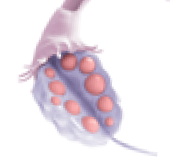
Polycystic ovary syndrome
A condition in which the ovaries produce higher than normal amounts of male sex hormones that interfere with ovulation.15 It is the most common cause of female infertility.16

Endometriosis
Occurs when tissue that normally lines the inside of the uterus is found in other places, like the fallopian tubes, and can cause blockages.15

Uterine fibroids
Noncancerous growths that can form in and around the uterine wall. Sometimes fibroids can affect fertility by:
- Changing the shape of the uterus or position of the cervix
- Blocking the fallopian tubes
- Interfering with blood flow to the uterus15
cervical mucus

Inhospitable cervical mucus
Can prevent sperm from entering the uterus.17
of the uterus

An unusual shape of the uterus
Can cause people assigned female at birth to have trouble getting pregnant or to miscarry.17, 20
disease
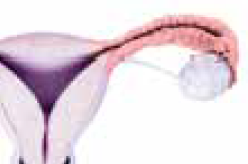
Pelvic inflammatory disease
Is usually caused by a sexually transmitted infection; it can cause damage and blockages in the fallopian tubes.17-19
Type of test they may order
Click on the tests below to learn how they are usedBlood test

Blood tests
For those assigned female at birth
For those assigned male at birth
Ovarian reserve testing4, 22
Provides a better understanding of egg quantity. This testing often begins with hormone assessments at the start of a menstrual cycle.
Anti-Mullerian hormone (AMH) testing23
Assesses AMH levels, which helps identify low ovarian reserves and helps predict how someone may respond to certain forms of ovarian stimulation.
Hormone testing22
Provides a better understanding of how hormones relating to reproductive processes are functioning.
Ovulation testing22, 24
A common blood or urine test that measures hormone levels to determine when ovulation is likely to occur.
Urine Tests

Urine tests
For those assigned female at birth
For those assigned male at birth
Hormone testing24
Provides a better understanding of how hormones relating to the menstrual cycle are functioning.
Ovulation testing22, 24
A common blood or urine test that measures hormone levels to determine when ovulation is likely to occur.
Imaging tests

Imaging tests
For those assigned female at birth
For those assigned male at birth
Imaging (such as MRI or ultrasound)22
Used to examine whether there are any underlying diseases, conditions or abnormalities.
Hysterosalpingography22
Assesses whether there are any blockages in the uterus or fallopian tubes. The procedure begins by injecting dye into the uterus, and is followed by an X-ray to check whether there are any blocks or leaks.
Pelvic ultrasound25
Used to examine whether there are abnormal follicles or problems with the ovaries or uterus.
Semen analysis tests

Semen analysis
For those assigned female at birth
For those assigned male at birth
Semen analysis6
Provides a better understanding of semen quality. After a specimen of semen is collected, it is sent to a lab, which analyses the count, motility and morphology of sperm.
Here are some suggestions to help you plan the next steps in your journey
Hope for the best, and reflect on past cycles
Take a moment to reflect on how you feel and how your treatment has been going. Refer back to your initial expectations:
- What was your plan?
- Have you reached the number of cycles you were willing to undergo?
- If so, it’s okay to say you’ve reached the end of your IVF journey; there are other options available to explore
- If not, it’s okay to take a breather and resume when you’re ready again
Don’t be afraid to ask questions and learn more about your situation
Be curious. Write down any questions you may have for your fertility specialist.
Discover alternatives to parenthood that don’t include ART
There is no one correct path to parenthood. Learn about other ways to create your family.
Learn MoreWhere would you like to start today?
Understanding infertility
Lorem ipsum dolor sit amet, consectetur adipiscing elit, sed do eiusmod tempor incididunt ut labore et dolore magna aliqua. Ut enim ad minim veniam, quis nostrud exercitation ullamco laboris nisi ut aliquip ex ea commodo consequat.
Explore my parenthood options
Lorem ipsum dolor sit amet, consectetur adipiscing elit, sed do eiusmod tempor incididunt ut labore et dolore magna aliqua. Ut enim ad minim veniam, quis nostrud exercitation ullamco laboris nisi ut aliquip ex ea commodo consequat.
Please answer the below questions to help find the path best suited for your situation.1–7
Path best suited for you
Traditional surrogacy5, 6
What is Elonva?
As you may recall from our ovarian stimulation section, your IVF therapies are timed alongside your menstrual cycle.1-5
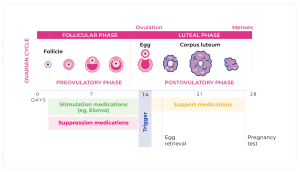
Elonva is a stimulation medication that belongs to a group of gonadotropic hormones. It is used to stimulate eggs in the ovary to grow and develop.
Unlike conventional follicle-stimulating hormone (FSH), another stimulation medication (which is given every day during the first 7 days of treatment), Elonva has been designed to replace 7 injections with 1 single injection. (Depending on your response, your physician may prescribe additional daily FSH injections after day 7.)
As you may recall from our ovarian stimulation section, your IVF therapies are timed alongside your menstrual cycle.1-5

Elonva is a stimulation medication that belongs to a group of gonadotropic hormones. It is used to stimulate eggs in the ovary to grow and develop.
Unlike conventional follicle-stimulating hormone (FSH), another stimulation medication (which is given every day during the first 7 days of treatment), Elonva has been designed to replace 7 injections with 1 single injection. (Depending on your response, your physician may prescribe additional daily FSH injections after day 7.)
Sperm production21

cases of male infertility are linked to low sperm count or sperm that do not function properly
Some of the potential medical conditions that could cause infertility
- Genetic
- Undescended testes (didn’t descend at birth)
- Infections (such as sexually transmitted infections)
- Torsion (twisting of the testes in the scrotum)
- Certain medications (eg, exogenous testosterone)
Sperm transport21

of cases of male infertility are linked to sperm transport problems, which can lead to a lack of sperm in the ejaculated semen
Some of the potential medical conditions that could cause infertility
- Infections (such as sexually transmitted infections)
- Prostate-related problems
- Absence of vas deferens
- Vasectomy
Resources
Explore our range of resources designed to provide education and support.Watch how to inject Elonva
Wondering how infertility is diagnosed?
Doctors use a range of diagnostic tests to help identify potential underlying factors that could impact fertility.
Still have questions?
For more information, please download the Consumer Medicine Information
Fresh Cycle
1Ovarian stimulation

2Egg retrieval

3Fertilisation – 2 options
They will aim to fertilise the collected eggs in one of two ways:
AIn vitro fertilisation (IVF)

BIntracytoplasmic sperm injection (ICSI) process

4Embryo development

5Embryo transfer

6Taking a
pregnancy test

Frozen Cycle
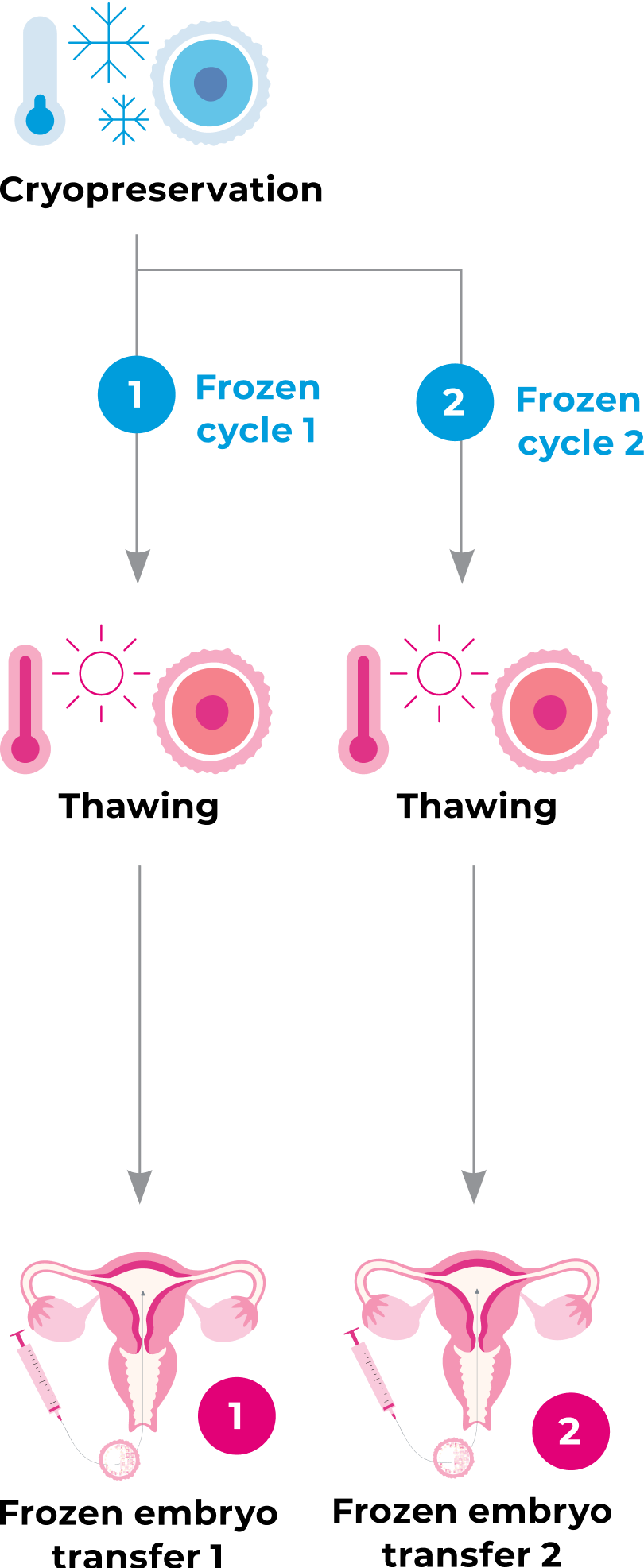
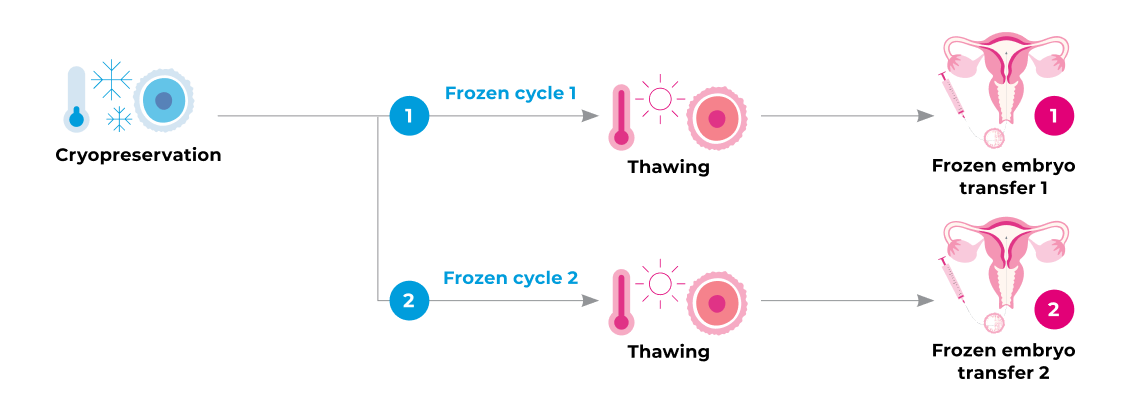
Frozen cycle
There may be more than one embryo that could be used for an embryo transfer, in which case your fertility specialist may suggest freezing the ones that won’t be used during the fresh cycle of ART.13
Cryopreservation of embryos has several advantages:
While cryopreservation offers many advantages, it also introduces a few social, ethical and legal concerns to consider. For example:23
Studies are still being conducted to determine whether fresh or frozen embryos are better. It’s best to consult with your fertility specialist to determine which is best for you.
Step 1
Ovarian stimulation
Medications that may be needed during the ART process
It’s important to know that one ART cycle correlates to one full menstrual cycle where treatments and procedures are carefully planned to enhance your body’s natural process.10
There are different brands of medications that can be used during the ovarian stimulation phase, but their aim is the same: stimulate the development of follicles to increase the chances of producing more than one viable egg for egg retrieval.3
Medication protocols are specific to you
When starting ART, your fertility specialist will assign you an appropriate treatment protocol based on diagnostic tests, which will take into consideration how you may respond to ovarian stimulation (ie, low, normal, or high response based on ovarian reserve and age) and/or prior ovarian stimulation response history (if you’ve undergone ART before).11,12 The difference for females that are low responders to ovarian stimulation is that fewer eggs may be retrieved.8
Here are a few things to know:6,13,14
- Stimulation medications will typically be introduced early in your cycle
- Since everyone responds differently to medications, your fertility specialist will be monitoring your progress through ultrasounds and blood tests regularly
- Based on their ongoing monitoring, they will adjust medications as needed
Common medication used for conventional stimulation
When medications may be introduced in a conventional stimulation6,13-16
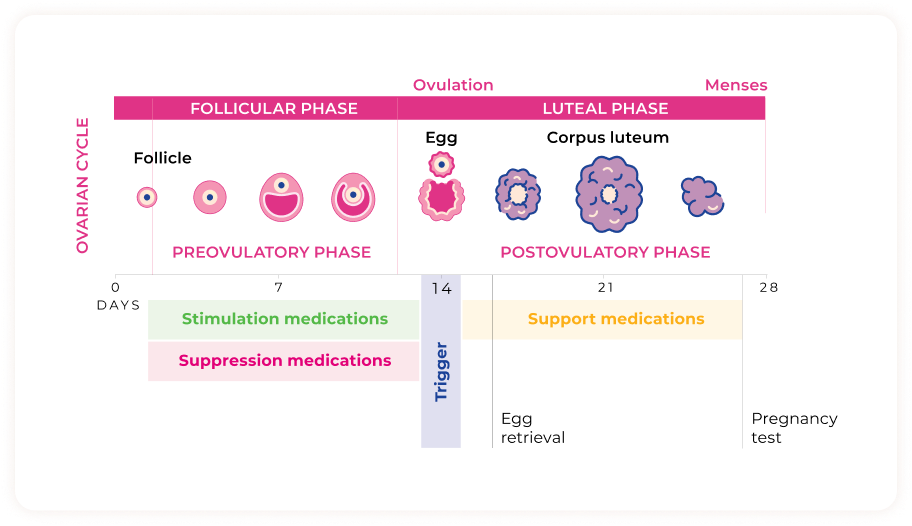
Try not to get too concerned by the type of medication prescribed, it’s more important to know what its role is. You can use the table to gain a better understanding of what the medication you’ve been prescribed is used for.
Common medication used for conventional stimulation
Like all medication, fertility medication can cause side effects
Some potential side effects include:16.17
Mild bruising at injection site
Nausea and vomiting
Hot flashes
Headaches
Mood swings and fatigue
If you experience a side effect that causes you discomfort or any other symptoms which concern you, be sure to speak to your fertility specialist or nurse about it. If you are experiencing any severe discomfort, don’t wait – visit an emergency department immediately.17
Step 2
Egg retrieval
What happens during the egg retrieval stage?
Your follicles will typically be ready for egg retrieval ~8–14 days after you begin your ovarian stimulation cycle,13 at which time you will be instructed by your fertility specialist to take medication in preparation for retrieval.14
Egg retrieval can be done at the clinic 34–36 hours after that final injection and before ovulation occurs.14 The number of eggs retrieved is directly related to the number of ovaries, ability to reach the ovaries, the level of stimulation and the number of follicles that developed in response to stimulation.18
What can I expect from the procedure?
During the procedure, you’ll be sedated or provided a local anaesthetic, and be given pain medication.14
- The usual retrieval method is through transvaginal ultrasound aspiration, where a probe is inserted into the vagina to visualise follicles. Once found, a needle is carefully inserted into follicles to retrieve eggs.
- The eggs are removed through the needle using a suction device. ~20 mins is needed to remove multiple eggs.
- After removal, it’s possible to feel mild discomfort from cramping or feelings of pressure.
- Eggs are then incubated and further examined to see if they are viable. Not all eggs collected will be able to be successfully fertilised.
At this point, eggs can either be:8
- Used in IVF to create embryos for a fresh transfer
- Frozen for future use
Step 3
Egg fertilisation
What happens during the egg fertilisation stage?
Below are two methods that can be used to fertilise eggs
In vitro fertilisation (IVF)
In this method, the collected eggs are placed with prepared sperm for fertilisation.14
Intracytoplasmic sperm injection (ICSI) process
In this method, a single healthy sperm is injected directly into a mature egg. This option may be used when semen quality or number is an issue, or if conventional fertilisation hasn’t worked in the past.14
Step 4
Embryo development
How long does it take for an embryo to develop?
After the sperm fertilises the egg, it takes about 3 days for an embryo, which contains about 6–10 cells, to form. The cells will continue to multiply, and by day 5/6 they become a blastocyst. The blastocyst is made up of two components: the inner group of cells, which is the developing embryo; and the outer group of cells, which form around the embryo to protect and nourish it.13,19
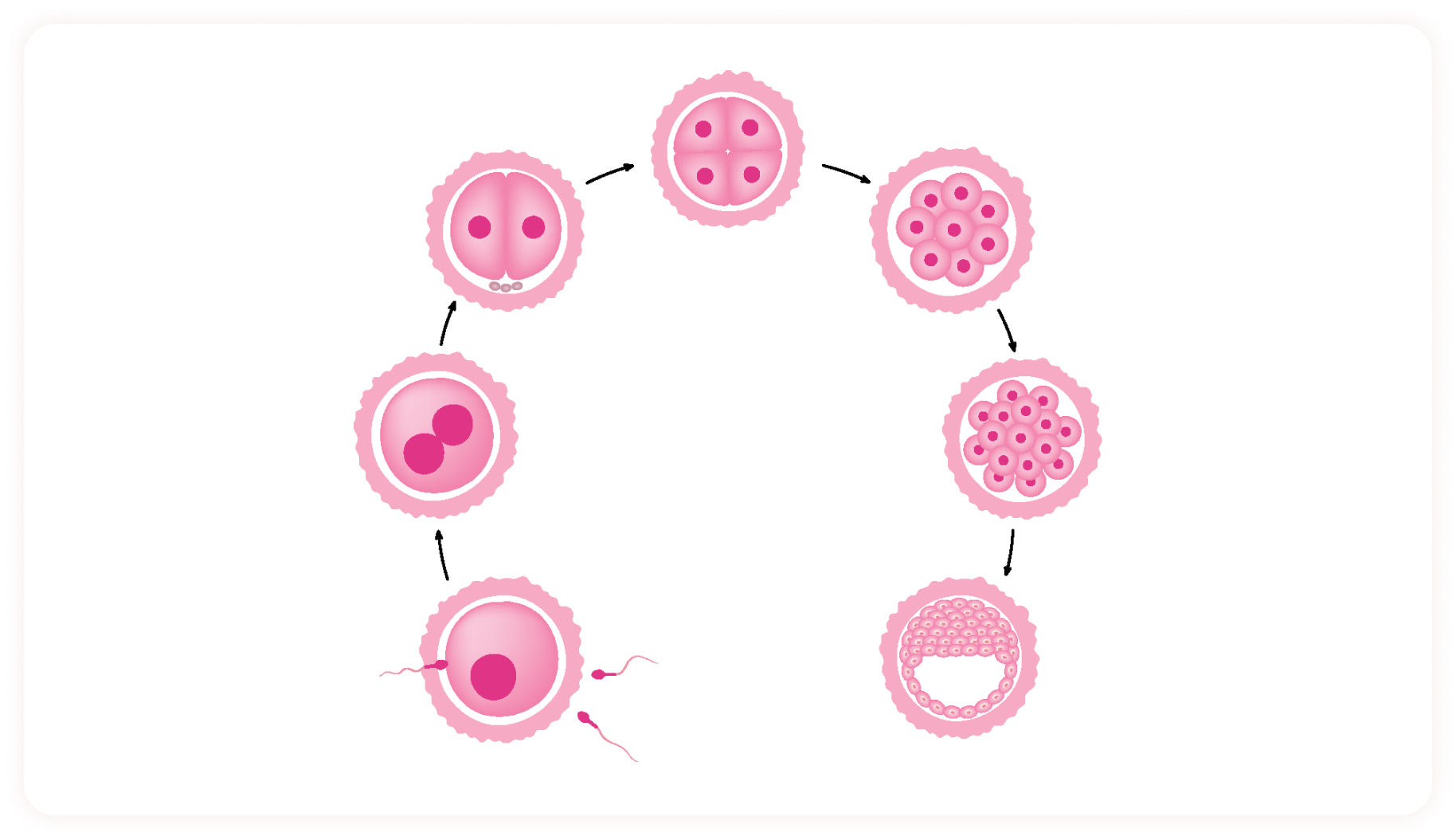
What is pre-implantation genetic testing?
Genetic abnormalities are more common when using sperm or eggs from older individuals. As such, while embryos are developing, a small sample, or biopsy, can be collected from each and used to screen for specific genetic diseases or abnormalities in a process called pre-implantation genetic testing (PGT). PGT consists of a set of different techniques, and the goal is to identify any genetic conditions or chromosomal abnormalities before implanting the embryo.6, 20
Although pre-implementation genetic testing aims to reduce the likelihood of parents passing on genetic problems, it doesn’t eliminate the risk in its entirety.6
Step 5
Embryo transfer
What can I expect from the procedure?
For a fresh cycle embryo transfer, the procedure can be done at the clinic around 2–5 days after egg retrieval. The procedure is usually painless, but a mild sedative can be used. Mild cramping could be experienced during the procedure.14
- A catheter (a long thin tube) is carefully inserted into the vagina, through the cervix, and into the uterus.
- A syringe that contains one or more of the embryos along with a small amount of fluid is attached to the end of the catheter.
- The embryo is then injected through the catheter and into the uterus.
- If successful, the embryo will implant in the lining of the uterus.
It is not guaranteed that the embryo will implant.
After the procedure typical daily activities can be resumed; however, it’s advised to avoid vigorous activity, which may cause some discomfort. Some common side effects that can occur during the procedure include:14
- Passing of a small amount of fluid or blood
- Breast tenderness
- Mild bloating and/or cramping
- Constipation
If you experience a side effect that causes you mild discomfort, be sure to speak to your fertility specialist or nurse about it. If you are experiencing any severe discomfort, don’t wait – visit an emergency department immediately.
For a frozen/thaw cycle embryo transfer, the procedure is similar.9 But remember, in order for the embryo to implant in the lining of the uterus, it needs to be ready. Thickening of the lining of the uterus happens in the luteal phase of the menstrual cycle,15 so your fertility specialist may perform tests to make sure the lining is ready for potential implantation prior to an embryo transfer.21 If it is not, medication may be given to get the lining prepared.14
Step 6
Taking pregnancy test
About 9–12 days after the embryo transfer, a pregnancy test will be performed to see if the IVF cycle was successful. If the pregnancy test result is positive, a second test is typically performed.18
If you’re pregnant, your fertility specialist will continue to monitor you for complications (ie, potential miscarriages, ectopic pregnancies, or multiple pregnancies) until you reach 8–10 weeks of gestation. After that, you will be cleared to go to your obstetrician of choice for the remainder of your pregnancy.18


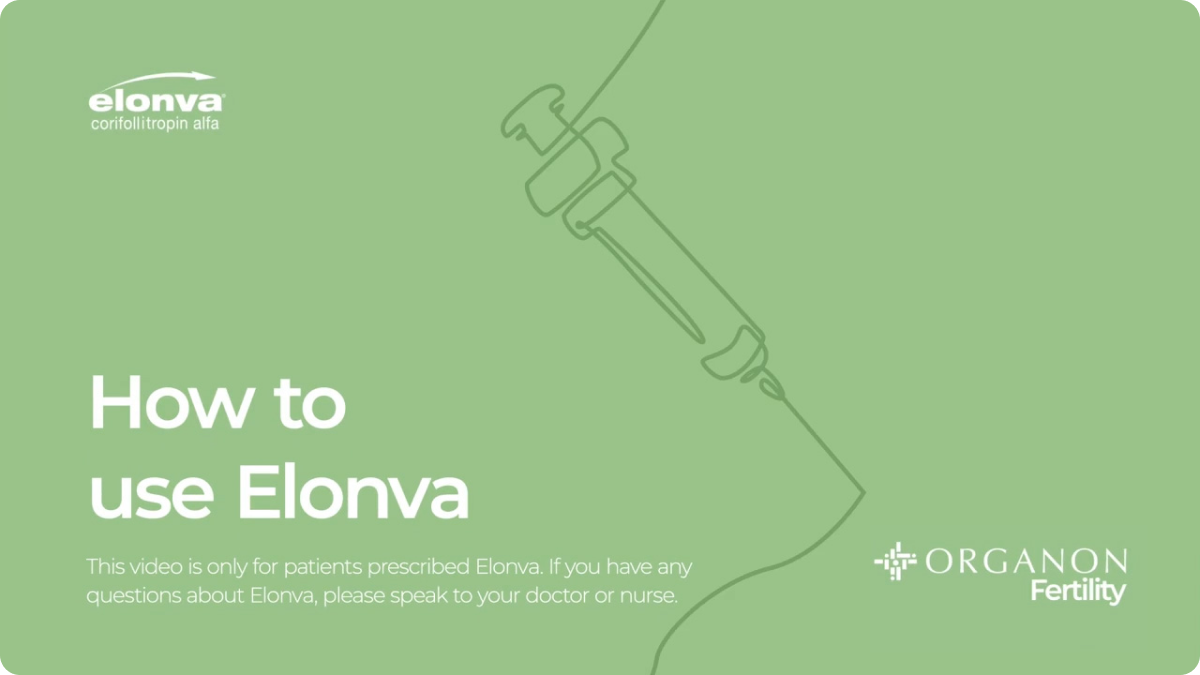
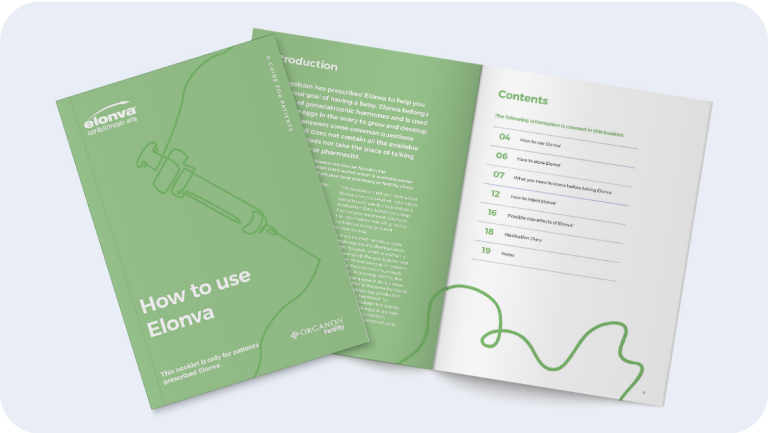
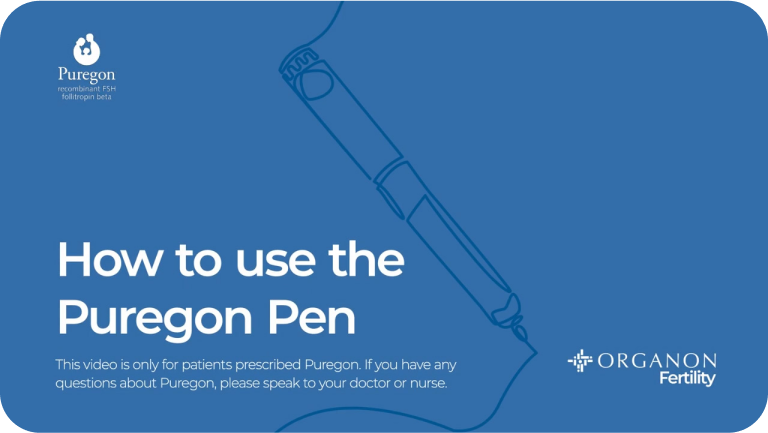
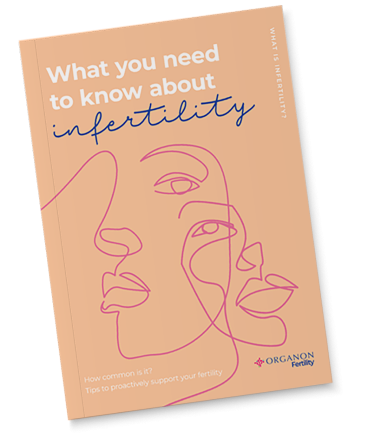
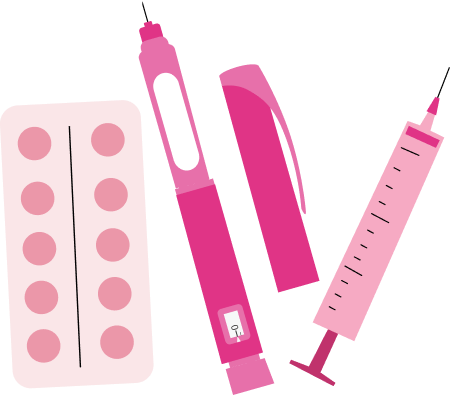
 Previous step
Previous step